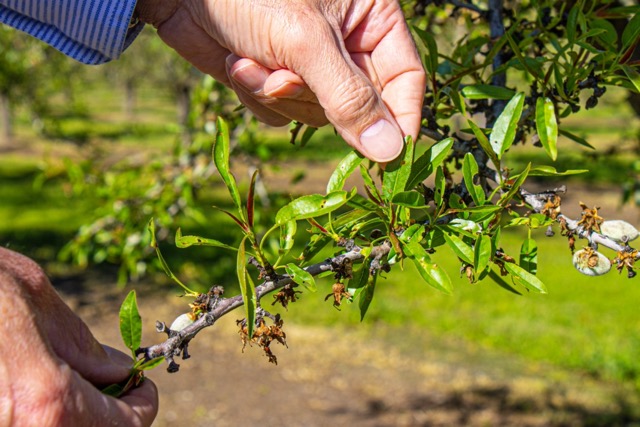
By Madeline Shannon
March 31, 2023 – As rain continues to pour down in an already-drenched Clovis, the city’s agricultural community is worried about how even more inclement weather in a city plagued by a decade-long drought will withstand any additional downpours.
“It’s the winter we all hoped and prayed for,” said Robert Rocha, sales manager at P-R Farms in Clovis. “This totally ended up being a wet year. Nobody saw this coming.”
The National Oceanic & Atmospheric Administration predicts a continuation of significant flooding throughout the state because of a series of strong storms coming in from the Pacific Ocean, resulting in not just record rains, but record snowpack.
Already this wet season, Fresno County saw 17.48 inches of rain as of March 29, far more than the annual average of 9.09 inches. In addition to the heavy rainfall, the Sierra Nevada mountain range between Yosemite and Kings Canyon got 62 feet of snow, putting the amount of snowpack this season at 252% of normal.
“We should only be at about 30 feet,” said Carlos Molina, a meteorologist with the National Weather Service office in Hanford. “It’s going to take a while to melt all that snow. It will be a quick melt for the lower elevations as far down as Shaver Lake, and you’ll see some effects from snowmelt in that area.”
Molina said flooding along the Kings River and San Joaquin River is very likely to continue throughout the spring and summer — possibly as far out as at least August.
“As we get into the summer, the rivers will continue to run high, possibly even until fall this year,” Molina said. “It’ll be an interesting year in terms of the rivers.”
It’s hard to imagine such inundation can follow such a long dry spell. According to the U.S. Drought Monitor’s animation tool that shows drought conditions in California, the San Joaquin Valley has gone from the D4 “exceptional drought” category, indicated by a deep red color, to the “none” category, indicated by white — all in the last 52 weeks. The drastic turnaround from drought to flood led Gov. Gavin Newsom to declare a state of emergency in 21 counties, including Fresno County, because of the increased flood conditions.
As rainfall helps groundwater conservation, crop production could suffer
After years of drought, local farmers are able to recharge their water supply after two years of 0% water allocation in some parts of the valley. The Bureau of Reclamation announced on March 28 that the Central Valley Project — which allocates water to valley farmers — would receive 80% of its water allocation under contract, up from the initial 35% allocation announced earlier in the season.
For many valley farmers, that provides a chance to replenish groundwater supplies after years of pumping groundwater almost exclusively.
“Last year was almost the complete opposite of this year,” Rocha said. “Our storms stopped very early. It was dry and warm, and unfortunately, we had to start watering with our pumps because there was no more rain. Now, we can conserve that groundwater, which is so important.”
As the rainfall helps the groundwater recharge, many Clovis farmers are worried about their ability to produce a crop on par with last year’s totals. Some saw their fields flooded so much that trees just felled themselves, toppling over in the heavy rains, one Clovis tree remover said.
“We’ve been getting quite a few calls between low-commodity prices for nuts and the inclement weather,” said Scott Houlding, a partner at Indegrow Enterprises, which provides tree removal, pruning and topping services for local farmers. “This is the first time I can say we’ve actively seen something like this. We’re in uncharted waters.”
More downpour, more diseases
With the rain come other problems, too. Some farms that rely heavily on production of nuts, like P-R Farms, are as concerned about rain as they are about hail and diseases on the trees that do lasting damage to the crop.
“Hail definitely does more damage to our crop that’s still out there,” Rocha said. “And there’s other pests, diseases and pressures we get from there being too much moisture.”
The heavy rains get the fields so wet that it’s difficult, sometimes impossible, to spray insecticides and pesticides on the trees, local farmers said. Many farms can’t even get spraying equipment on the fields because of the flooded ground. As a result, diseases that commonly plague unsprayed trees are showing up in the fields, Rocha said.
“We’re starting to see some of the diseases that can affect the bloom,” Rocha said. “Shot hole is one that you get, and it really affects the fruit that you’re looking to develop or the leaves on the tree.”
Shot hole and bacterial blast, two diseases that can strike almond trees when the sprays aren’t applied to the trees early enough in the season, are showing up already. Shot hole, true to its name, looks like someone shot a tiny hole through the leaves of the Independence-variety almond trees, one of the almond tree varieties most susceptible to the disease.
P-R Farms, along with many other farms in the Clovis area, are seeing the brown, dried-up leaves Rocha described as “burned off” on Independence-variety almond trees because of bacterial blast, which is also commonly referred to as citrus blast because it also strikes citrus trees.
“Certain varieties are more susceptible to this,” Rocha said. “We got freezing temperatures and then the rain that we got caused a lot of this.”
According to the National Weather Service, more rainfall in the valley and more snowpack in the Sierra Nevada in the coming weeks will only add to the excessive water supply this year. The farming community in Clovis is trying to find the silver lining, Houlding said.
“We’re a resilient sort, to say the least,” Houlding said. “We’re going to try to find a way through this. I’m amazed at what folks come up with and do.”








